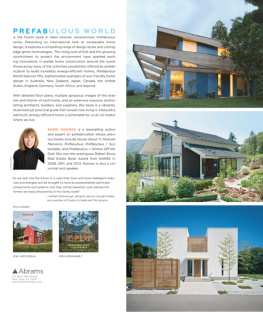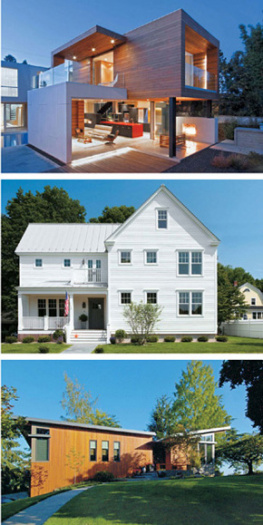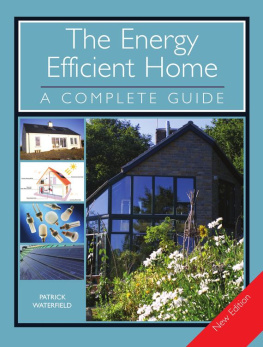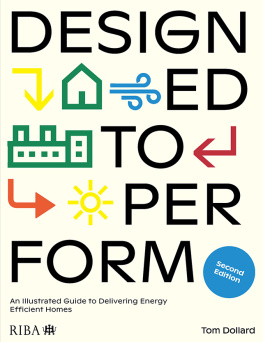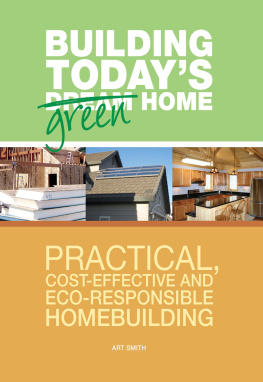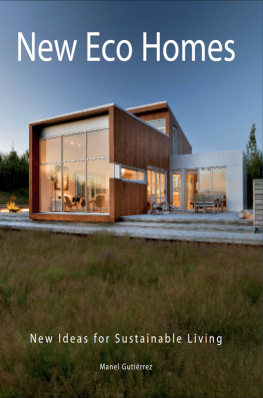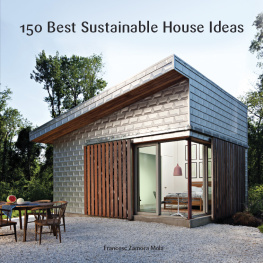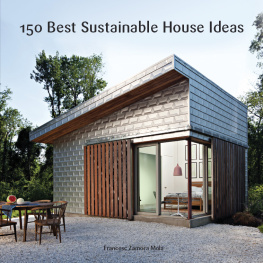

) is of the surrounding mountainsMonte Lema, Monte Tamaro, and Monte Rosa. On a clear day, you can see all the way to Italy, a distance of about 112 miles (180 km). (Photo courtesy of Grandpierre Design GmbH)
To all of those who work to make the world green, and to my dear friends, who keep my world rosy.

), has a powerful photovoltaic array, which produces clean solar energy.
ACKNOWLEDGMENTS
I wanted to write this book because the inefficient usage of energy and water, limited resources, and an abundance of waste are global problems that are not restricted to any particular country. Because the worlds energy and resources are not being used optimally in so many locations, it continues to be an important issue for us all. I believe people from all countries can learn a great deal by sharing information on how efficiency in construction is being achieved in many different ways, in many different places.
This book was more challenging to write than all of the others Ive written so far because of language barriers, the complexities of different local and national codes and requirements, and just plain distance. I want to thank all of the architects, builders, homeowners, and other professionals who were so helpful and patient working with memany of them whose first language is not English.
Thank you to all the photographers who graciously shared their beautiful photographs with me.
Many thanks to my building friends who continue to inspire and help me with technical issues: Dave Wrocklage, John Connell, and Adam Prince with his colleagues at Zero Energy Design. And to Denise Marcil and Lucy Hedrick for your friendship and great support for all of my book projects. Thanks to Michelle and Alexander Kolbe, who have been my European connection and have been so helpful.
Thank you to Mary Doyle-Kimball and the members of NAREE for your continuous support for my books.
My thanks to Robert Redfordyou have been such an inspiration to me and a huge gift to this country. Thank you to Joyce Deepyour work inspires me, and your support brings me joy.
My familyRob, Alex, and Jesseprovide much of the incentive for wanting to improve the environment. I wish for a cleaner, healthier environment for them, and for all living things that reside on this planet.
My gratitude to my brother, Mark Warman, and my sister, Barbara Corpuelyou are both wonderful friends and great supporters of my life and work.
Special thanks to Chuck Lockhart for your efforts, beyond the call of duty, in creating meticulous graphics.
Thank you to Eric Himmel. Im so appreciative of your continued support for my work. And thanks to Laura Dozer for your fine editing and Darilyn Carnes for your magnificent graphic design.

), was panelized with parts that could be flown in by helicoptor because of the limited accessibility of the site.
CONTENTS

), seen here nestled among tall pine trees, was the first certified Passivhaus in Denmark. (Photo by Thomas Sndergaard)
FOREWORD
A n important part of my lifes work has been to preserve this land we hold so dear, conserve our natural resources, keep the air we breathe healthy, and protect all living things from the disasters associated with obtaining fossil fuel. Although much of the work I have done has been focused in North America, environmental threats know no boundaries, and all countries must work to reverse the results of global warming and halt the decimation of our land in the name of energy.
One of the best ways to deal with these overwhelming goals is to reduce the amount of fossil fuel required to heat, cool, and ventilate our homes and other buildings. With about 40 percent of the energy used in this country and others around the world toward this end, reducing the need for fuel in our buildings and substituting renewable energy for fossil fuel can make a tremendous difference in our environment. The availability of technology to reduce energy consumption in homes is better than it has ever been in the past, and the mechanisms to capture renewable energy are also more readily available and at a lower cost.
Some countries around the world have taken the challenge to reduce the use of fossil fuel very seriously. One of the important goals of the European Union (EU), for example, has been to improve energy efficiency and to meet their commitments on climate change, made under the Kyoto Protocol originally adopted in 1997. In 2008, the EU agreed on an integrated approach to climate and energy policy called the Climate and Energy Package with the aim of transforming Europe into a highly energy-efficient, low-carbon economy. Its midterm targets, known commonly as the 20-20-20 targets, include a 20 percent reduction in greenhouse gas emissions from the 1990 levels, an increase to 20 percent renewable energies (in the total energy consumption in the EU), and a 20 percent improvement in energy efficiency across all EU countries by 2020.
Other countries around the world have also been working toward reducing the use of fossil fuel and, like the EU, are attempting to reduce the wasting of natural resources and increase the preservation of land. There are a multitude of certification programs for homes around the world, which were created to help reduce energy consumption. Several of the houses certified by these programs are profiled in this book.
In North America, we have established numerous guidelines and certification programs for home construction, as well as other types of construction. These have inspired homeowners, architects, and builders to meet the challenges established by these programs, such as LEED for Homes, ICC National Green Building Standard certification, and Passive House.
Sheri Kooness books have inspired professionals and homeowners to consider using prefabrication methods that reduce waste, inherently conserve energy, and limit the need for fossil fuel. This latest book, Prefabulous World, demonstrates the valiant efforts by builders around the world to use prefab methods to build houses that not only are beautiful but also substantially reduce energy usage and drastically reduce construction waste. I hope these examples will inspire you as they have inspired me.
Robert Redford
Environmentalist, Actor, Director

) is accessible via a light-colored natural stone staircase. The wine-red front door has a large glass frame, which lets natural light flood into the interior. All materials used to build the home were tested by organic biologists for pollutants. (Photo courtesy of Anton Stefars)
INTRODUCTION
A s a society we are becoming increasingly concerned about this planet we inhabit. We need the water we drink to be clean, the air we breathe to be unpolluted, and the homes we reside in to be healthy. We all want to leave this earth intact so future generations will have resources and be able to enjoy the natural beauty of our planet.
Next page
